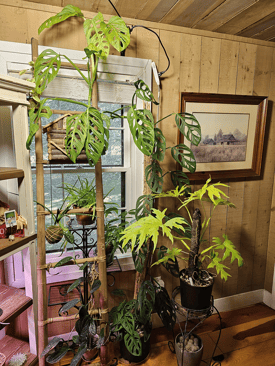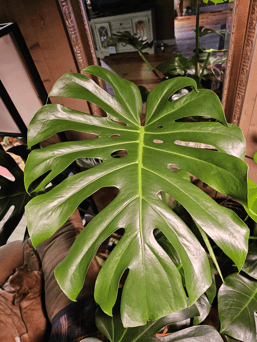Winter Is Coming: Preparing Your Indoor Houseplants for the Cold Season
As the days grow shorter and the temperatures drop, it's time to start thinking about bringing your beloved outdoor plants back inside for the winter. While indoor houseplants are a great way to bring greenery into your home year-round, the transition from outdoor to indoor can be a bit challenging for both you and your plants. In this blog post, we'll guide you through the process of preparing your indoor houseplants for the winter months, focusing on managing pests and adjusting your watering schedule.
1. Pest Management
Inspect Your Plants: Before bringing your outdoor plants inside, give them a thorough inspection. Look for any signs of pests such as discolored leaves, webbing, or tiny insects. If you spot any issues, it's crucial to address them before bringing the plants indoors.
Isolate New Additions: If you've acquired new outdoor plants over the summer, it's a good practice to keep them separate from your existing indoor plants for a few weeks. This quarantine period helps ensure that you don't introduce any pests to your established indoor garden.
Natural Remedies: Consider using natural pest control methods like neem oil or a mild soap and water solution to treat affected plants. These solutions are less harmful to your plants and the environment compared to chemical pesticides.
Regular Monitoring: Continue to monitor your indoor plants throughout the winter. Pests can still be active, albeit at a slower pace, in the warm and dry conditions of your home. Early detection is key to preventing infestations from spreading.
2. Adjust the Watering Schedule
Reduce Watering Frequency: One of the most significant changes you'll need to make is in your watering routine. With lower light levels and cooler temperatures indoors during the winter, your plants won't require as much water. Allow the top inch or two of the soil to dryout before watering and be cautious not to overwater.
Use Room-Temperature Water: Cold water can shock your indoor plants, so try to use room-temperature water when watering them. Letting the water sit for a day before using it can also help remove chlorine and other chemicals that might be harmful to your plants.
Humidity Control: Central heating systems can create dry indoor environments, which many houseplants don't appreciate. Increase humidity around your plants by using a humidifier, placing a tray of water near them, or misting the leaves regularly.
Consider Pot Size: If your plant has outgrown its current pot, winter can be an ideal time to repot. A slightly larger pot with fresh potting soil can provide your plant with the nutrients it needs for healthy growth during the winter months.
3. Lighting Your Indoor Plants
Ensuring proper lighting for your indoor plants during the winter is crucial for their health and growth. Here's how to make the most of the available natural sunlight and consider the use of LED supplemental lighting:
4. Utilize Natural Sunlight:
Assess Your Indoor Space: Before winter arrives, evaluate the light conditions in your home. Identify the sunniest spots where your plants can thrive. South or southwest-facing windows typically receive the most sunlight, making them ideal for light-loving plants.
Rotate Your Plants: As the angle of the sun changes during the winter months, make it a habit to rotate your plants regularly. This ensures that all sides of the plant receive equal sunlight and prevents them from leaning toward the light source.
Trim Overhanging Branches: Trim any outdoor trees or shrubs that may have grown to block sunlight from reaching your indoor plants. Pruning can help maintain the light conditions in your home.
5. Consider LED Supplemental Lighting: Assess Light Requirements: Different plants have varying light requirements. Some may need more light than your indoor space can provide naturally. LED grow lights are an excellent solution for supplementing light when natural sunlight is insufficient.
Assess Light Requirements: Different plants have varying light requirements. Some may need more light than your indoor space can provide naturally. LED grow lights are an excellent solution for supplementing light when natural sunlight is insufficient.
Choose the Right LED Lights: Opt for full-spectrum LED grow lights that mimic the spectrum of natural sunlight. Position them above your plants at an appropriate distance, as specified by the manufacturer, to avoid burning or stressing your plants.
Set a Lighting Schedule: Establish a consistent lighting schedule for your indoor plants. Most plants require 12 to 16 hours of light per day. Using timers can help automate this process and ensure your plants receive the right amount of light.
Monitor Plant Response: Keep an eye on how your plants respond to the LED lighting. If you notice signs of stress, such as leaf discoloration or wilting, adjust the light intensity or duration accordingly.
By optimizing natural sunlight and incorporating LED grow lights where necessary, you can provide your indoor plants with the ideal lighting conditions they need to thrive during the winter months. Remember to tailor your approach to the specific light requirements of each plant species in your collection, and you'll be rewarded with healthy and vibrant greenery even when the days are short and dark.
In conclusion, transitioning your outdoor houseplants indoors for the winter requires careful attention to detail, especially when it comes to pest management and adjusting your watering schedule. By following these tips, you can help ensure that your indoor garden thrives even during the coldest months of the year. Remember that each plant may have unique requirements, so it's essential to research specific care instructions for the species you have. With a little TLC, your indoor houseplants will continue to bring beauty and life to your home throughout the winter season.
Tags:
Oct 23, 2023 12:00:00 AM


Comments